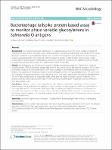Bacteriophage tailspike protein based assay to monitor phase variable glucosylations in Salmonella O-antigens
Schmidt, Andreas
Rabsch, Wolfgang
Broeker, Nina K.
Barbirz, Stefanie
Background: Non-typhoid Salmonella Typhimurium (S. Typhimurium) accounts for a high number of registered salmonellosis cases, and O-serotyping is one important tool for monitoring epidemiology and spread of the disease. Moreover, variations in glucosylated O-antigens are related to immunogenicity and spread in the host. However, classical autoagglutination tests combined with the analysis of specific genetic markers cannot always reliably register phase variable glucose modifications expressed on Salmonella O-antigens and additional tools to monitor O-antigen glucosylation phenotypes of S. Typhimurium would be desirable. Results: We developed a test for the phase variable O-antigen glucosylation state of S. Typhimurium using the tailspike proteins (TSP) of Salmonella phages 9NA and P22. We used this ELISA like tailspike adsorption (ELITA) assay to analyze a library of 44 Salmonella strains. ELITA was successful in discriminating strains that carried glucose 1-6 linked to the galactose of O-polysaccharide backbone (serotype O1) from non-glucosylated strains. This was shown by O-antigen compositional analyses of the respective strains with mass spectrometry and capillary electrophoresis. The ELITA test worked rapidly in a microtiter plate format and was highly O-antigen specific. Moreover, TSP as probes could also detect glucosylated strains in flow cytometry and distinguish multiphasic cultures differing in their glucosylation state. Conclusions: Tailspike proteins contain large binding sites with precisely defined specificities and are therefore promising tools to be included in serotyping procedures as rapid serotyping agents in addition to antibodies. In this study, 9NA and P22TSP as probes could specifically distinguish glucosylation phenotypes of Salmonella on microtiter plate assays and in flow cytometry. This opens the possibility for flow sorting of cell populations for subsequent genetic analyses or for monitoring phase variations during large scale O-antigen preparations necessary for vaccine production.
No license information

